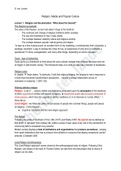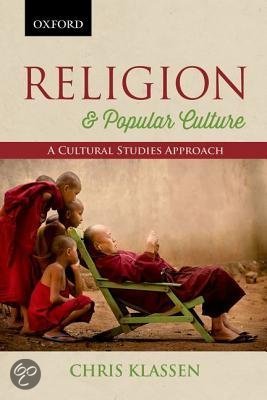S. ten Lande
Religion, Media and Popular Culture
Lecture 1 - Religion and Secularization: ‘What about the Sacred?’
The Passion as example
The video of the Passion ‘Je bent niet alleen’ brings to the forefront:
- The continuity and change of religious traditions within societies.
- The use and importance of new / mass media.
- The overlaps between celebrity culture and religious worship.
- The overlaps between popular cultural genres and religion
‘’Is seen as a free musical event, an excellent form of city marketing, a contemporary form of worship, a
sacrilege, reli-kitsch, a way to express the virtue of love, an experience of unity and / or solidarity, a
e
spectacular TV show, evangelization, and many other things, depending on whom one asks.”
nd
Taylor - Age of Authenticity
Taylor gives us a framework to think about the socio-cultural changes that influence the place and role
of religion in late-modern society. The framework helps us to think but also has a number of drawbacks.
Religion today
la
In chapter 14 Taylor states: “In particular, I hold that religious longing, the longing for and a response to
a more-than-immanent transformation perspective… remains a strong independent source of
n
motivation in modernity.” | 2007, 530.
te
Working definition religion
Religion: ‘a set of ‘’... actions, beliefs and institutions predicated upon the assumption of the existence
of either supernatural entities with powers of agency, or impersonal powers or processes possessed of
a
moral purpose, which have the capacity to set the conditions of, or to intervene in, human affairs.’’.’ |
Steve Bruce.
id
Lived religion: ‘we follow the paths and processes of people who consider things, people and places
as religious. | Chris Klassen
er
● Cognitive, functional and the lived religion approach
The Sacred
Sh
Following the works of Durkheim (1912), Otto (1917) and Eliade (1957) the sacred can be defined as
that which: is ‘set apart’ from ordinary life; instills a sense of awe; plays a key role in the reproduction of
community; and is considered very powerful.
Modern society displays a host of institutions and organizations that produce sacredness - ranging
from sports federations that help to produce hero-athletes to museums that display exceptional ‘sacred’
artworks | Chidester 2005.
Lived Religion & Anthropology
The Lived Religion approach comes closest to the anthropological study of religion. Following Chris
Klassen, who draws on the work of Thomas Tweed, we start from the presumption that no theory of
religion can be static.
,S. ten Lande
Secularization
1. The decline of popular religiosity
- Religion becomes less popular if they secularize.
2. The decline of the public presence of religious symbols and values, privatization of religion
- Religion could be popular and isn’t declining, but religion is relegated to the private
sphere. Isn’t part of collective life that can at one part have political power.
3. The separation of state institutions from religious institutions
The secularization thesis
- When societies move from ‘tradition’ to ‘modernity’, following interlocked processes appear:
● Separation from religion and politics, economics and science
● Privatization of religion in its own sphere (distinction private/public sphere)
● Declining social significance of religious belief
e
nd
Three general possibilities for relationships between state and religious communities
1. Fundamental unity of the national church or other central religious organization and the state.
Example?
2. Clear separation (anti-clerical or relatively indifferent). Examples?
la
3. Functional, but no strict separation, with cooperation in a broad range of fields. Example?
Religion and Nationalism: Some historical, actual and future outcomes
n
In reality no disappearance, but transformation of religion, religions often become nationalized. Thus
there is no ‘return’ of religion in a strict sense.
te
The formation of national identities around religion (Baumann 1999). Religion often becomes one of the
defining features of nations, like language and descent, i.e. ‘race’. Peter v.d. Veer (1994) critiques
Benedict Anderson > nationalism did not replace religious sentiments.
a
How should we analyze the relation between religion and the state?
id
- Reevaluate the concept ‘religion’ in light of the modern transformations of society.
- Reevaluate the concept ‘secular’ in light of the same transformation.
er
- Abolish the a-priori opposition between rational debate and religiously inspired reasoning /
practicing.
Sh
Secular(ism)
Secularisme = de overtuiging dat religie en geloof geen invloed mogen uitoefenen op de maatschappij.
Emergence of the modern concept of religion as a sphere of life different from law, society, and
economy; ‘Religion’ a product of modern governmentality. Religion and secularism define and
presuppose each other, and that means that analytically speaking, we can never separate religion from
politics.
Religion & Politics
1. State has to define what religion is (even) under conditions of religious freedom, and state
separation from religion
2. Religion isn’t just a matter of inner private belief, but also of bodily discipline and public practice
and therefore linked to power, and thus political in a wider sense.
, S. ten Lande
Seminar 1
Durkheim
Religion = collective aka society
Rituals / rites and beliefs.
Sacred versus profane → some things can be sacralized by the commutative society
- Profane = everyday life, everything normal
- Sacred = something higher than life itself.
How we can unpack religion to understand the concepts it contains.
Taylor
Paleo, Neo and Post-Durkheimian
Religion is a collective gathering. Depends on definitions of religion.
e
nd
Lecture 2 - Religion and Popular Culture: ‘Why we need Anthropology’
Nuestra Santisima Muerte (Our Most Holy Death) - documentary summary
“Holy Death, protect us. Holy Death, hear us. Holy Death, come into us. Holy Death, be with
us…” These are the words of a prayer offered once a month before an altar set up on a street corner in
la
Mexico City. They are praying to La Santisima Muerte, “Holy Death, or “Saint Death,” the female
personification of death. This documentary explores the unique religious subculture that idolizes death
and has gained mainstream notoriety in Mexico for it’s poor and criminal following.
n
According to one devotee, when death makes itself present on the streets and in the homes, it
demands devotion. The only thing that can protect you from death is death itself.
te
One man testifies that once two robbers got on a bus and demanded that everybody give them
a five peso coin, so they wouldn’t have to steal all their belongings. He says that he was about to hand
over the coin when one of the thieves saw his image of Santa Muerte and told him to put away his coin
a
because he respected the “little boss lady.” In their reasoning, Santa Muerte doesn’t allow anyone to
mess with those who believe in her, and anyone who does, pays a high price.
id
Some say that the worship of death started when criminals began to look for a patron saint to
which they could entrust themselves. In the late 70s and early 80s a gang of satanic drug dealers
began to kidnap people in order to offer human sacrifices. They even drank human blood on a few
er
occasions. Eventually the human sacrifices were eliminated but the idea of worshiping death stuck. A
Santa Muerte worshiper is simply somebody who is looking for something to believe in.
Sh
Santa Muerte believers claim that this Holy Lady has granted them the privilege of seeing and
experiencing what can be found beyond this earth. Altars and shrines are set up in store windows and
in churches. Devotees stop to cross themselves and pay respect to death by touching her wedding
garments in awe. They invoke her to protect and clean their homes. Believers are encouraged to sense
the presence of their dead loved ones because they have come to warn them of impending danger.
Many claim that they are establishing a new religion because people are hungry to find out how
to live better lives. Hence, this has now become Mexico’s fastest growing cult. Interestingly enough,
most Santa Muerte devotees continue to consider themselves to be Catholic.
Recap L1
Secularism is a normative ideology about the borders between religion and other domains of
socio-political life (not necessarily bad). Secularization as a theory of modernization cannot be





